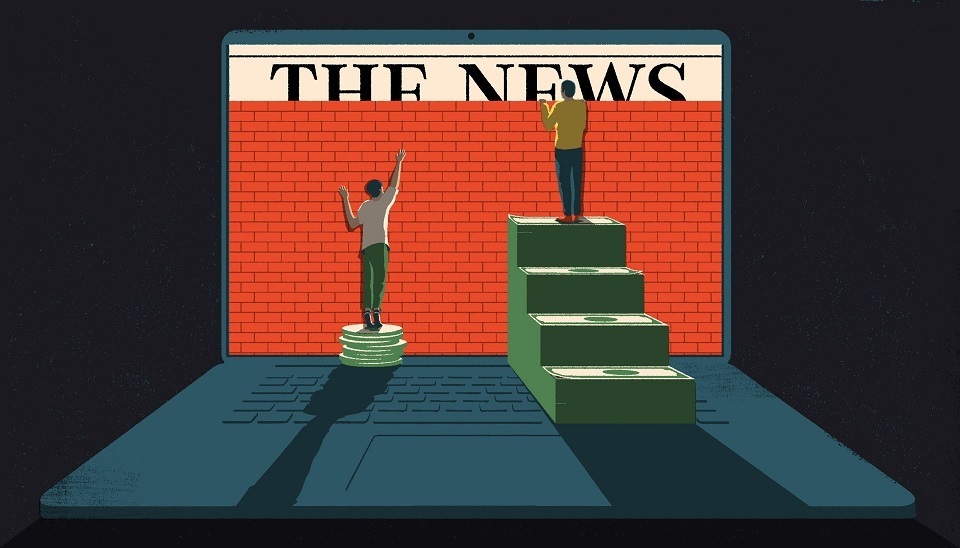
By Shehlat Maknoon Wani
LAST month, while scrolling through my Twitter feed, I came across a Tweet from an Indian writer. In brief one-liners, the writer fumed at people who do not pay and subscribe for news. “Don’t be cheap. It will cost you the price of a cup of coffee at Barista/Starbucks for a monthly subscription.” It made me wonder if this is the solution to the crisis that Indian news media is facing.
It was around two centuries ago when the steam-powered press made newspapers cheap and affordable in America. These low-cost newspapers were called the penny press newspapers. They were sold for a penny when most of the newspapers cost six pennies. These newspapers initially relied on printing gossip but later ventured into hardcore journalism. The penny press newspapers revolutionized journalism by making news affordable to middle-class citizens. The reportage also became more diverse as the audience demanded more news relevant to them.
We have entered 2021, and the Internet has taken over the conventional forms of news media in most developed countries. The newspapers and T.V. news channels are focusing more on online platforms like YouTube and Facebook, paying special attention to mobile applications to reach more audiences. In India, however, the conventional news media is booming like always. One of the reasons for this could be that the internet penetration in the country is still very low and newspapers and television news are more readily available to people. Internet accessibility in India is increasing exponentially; however, the ability to pay for content has not seen the same growth.
Newspapers like the New York Times and Washington Post have grown their subscriber base to millions, and they have a significant influence on American politics, but it is foolish to assume that the same could happen here anytime soon. Even in America, only 20% of readers pay for news, while a minuscule 25% are willing to pay for it. According to a research published by the Reuters Institute in 2017, globally, 54% of people were unwilling to pay for news. The number might be even lower in India. Moreover, most of the audience in India is already hooked to jingoistic news media, and they have a little understanding of how news is different from entertainment. In such a scenario, the subscription model cannot work as an alternative to advertisement.
If journalism is the fourth pillar of democracy, how can we put it behind a paywall? News is impactful only when it reaches the audience – a significant number of people who can make informed decisions by consuming objective news. An exclusionary subscription model risks limiting access to bias-free reporting and creating an informational divide between those who can pay for the news and those who cannot. Journalism’s failure to reach the masses will be a crisis for democracy.
News does not come cheap. It takes a lot of resources to gather and disseminate it, so we need an efficient model to fund this profession. The age-old publisher-editor rivalry needs to be reexamined to find a solution to this problem. The advertisement model may have kept news organizations afloat and generated huge profits, but it has also led to a degradation of journalism across the world. News organizations have to adopt a model that can satisfy their financial needs and — at the same time — allow them to report objectively. It is a difficult task to find such a solution and then convince people to adopt it. However, ensuring that news is accessible to people — even those who cannot pay for it — is indispensable to the cause of journalism.
Penny press revolutionized journalism two centuries ago. It made news available to workers and peasants who could not previously afford it. A subscription model that puts most of the content behind a paywall will reverse the strides this profession has made over these years. Moreover, it will also give corporate-owned media houses a free run in the market. The exclusionary system created by such policies will outweigh any benefits that may or may not accrue from them.
Journalism needs a rescue. News channels in India are competing with reality T.V. shows. It is well established that the noisy prime-time debates are conducted to grab attention of the audience rather than inform them. To that effect, we need to change the way people understand the news and its objectives. The line between entertainment and journalism has blurred and, to redraw that line, it is imperative to reach out to a large number of people.
The views expressed in this article are the author’s own and do not necessarily reflect the editorial stance of Kashmir Observer.
- The author can be reached at [email protected]
Follow this link to join our WhatsApp group: Join Now
Be Part of Quality Journalism |
Quality journalism takes a lot of time, money and hard work to produce and despite all the hardships we still do it. Our reporters and editors are working overtime in Kashmir and beyond to cover what you care about, break big stories, and expose injustices that can change lives. Today more people are reading Kashmir Observer than ever, but only a handful are paying while advertising revenues are falling fast. |
| ACT NOW |
| MONTHLY | Rs 100 | |
| YEARLY | Rs 1000 | |
| LIFETIME | Rs 10000 | |













